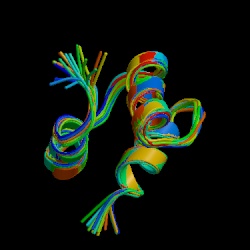
Photo courtesy of CNN News
The 'Longevity' Gene
This webpage was produced as an assignment for an undergraduate course at Davidson College
Jeanne Calmet was believed to be the world's oldest person (with official proof of her birthdate), when she died at the age of 122 in 1997. Thus far no one with proof of their birthdate has been able to live past that age, with the most recent 'world's oldest person' dying at age 116. Jeanne Calmet attributed her long life to "Port wine, a diet rich in olive oil, and her sense of humor" (CNN News). However if that was the only cause of her longevity, there would be many more people living to the ripe age of 122.

Photo courtesy of CNN News
The question of what allows some people to live past the age of 100 is a question that has forever intrigued the human population. Since the discovery of DNA and the idea of a genetic trait that allows for such old age, scientists have searched for the elusive 'cause' of longevity. In the general population, many people expect scientists to find 'the' longevity gene, however the scientific community understands that something so complex as lifespan is controlled by many, many factors. A common misconception is that once the reasons for a long lifespan have been discovered, they can be induced in those who do not inherit the trait naturally. "The 'secret formula' for aging long and well may soon be available at your local pharmacy" (National Geographic News). Most likely, there are several genes that control a number of factors, and those factors can be influenced by environment, stress, and diet.
When the scientific community publishes a paper that deals with a hot topic in the media, often the popular press attempts to summarize the scientific paper for the general population. As a result of this popular interpretation, the media representation is quite often not very accurate. As an example of this inaccuracy, we can examine the media attention on the "longevity" or "old age" gene.
Scientific Article
There have been several articles published within the last 2 years that deal with a gene known as SIRT1 in humans (the yeast homolog Sir2). The most recent publication is from Science, where the authors used Saccharomyces cerevisiae as their first model organism. Authors Cohen, et al. found that restricting the caloric intake of yeast caused activation of Sir2 deacetylase, which caused an aging delay in the yeast. Rats, a closer model organism to humans, were then tested with the same calorie restriction and the equivalent mammalian gene, SIRT1, was induced in these animals. The research found that "SIRT1 deacetylates the DNA repair factor Ku70... thereby inhibiting stress-induced apoptotic cell death" (Cohen, 2004). This effect from the SIRT1 deacetylase could be the cause of increased life span by promoting the survival of irreplaceable cells.
The article then states "A critical step in initiating stress-induced apoptosis is the relocalization of the Bax protein..." (Cohen, 2004). It is known that Ku70 regulates Bax localization, and the authors speculated that perhaps SIRT1 and Ku70 would work together to determine susceptibility of a cell to apoptosis due to stress. Using cells that overexpressed SIRT1, the researchers found that Bax-mediated apoptosis was suppressed, and with cells that did not express SIRT1, the number of cells undergoing Bax-mediated apoptosis increased.
Knowing that SIRT1 works through deacetylation, the researchers hypothesized that SIRT1 deacetylizes Ku70, and described their methods for testing this hypothesis. The result was that they discovered they were correct in their hypothesis, and they went on to determine that Ku70 is deacetylized at two lysines in the C-terminus that are critical for regulating Bax.

The Ku70 protein (image from the Protein Database)
From this scientific article we obtain the understanding that caloric reduction stimulates the production of SIRT1, which then interacts with Ku70. Together, they regulate the localization of Bax, which then determines the susceptibility of a cell to programmed cell death. This is a very short summary of the article, however keeping this in mind, we now examine the popular press article written as a summary for the general public of this scientific article.
The structure of the human SIRT1 gene has not been established as of yet, however the structure of the yeast homolog Sir2 has been determined and can be found at the Protein Database. The sequence of the human SIRT1 gene can be found here: SIRT1 Sequence .
Popular press article
The idea that a reduction in calories could cause humans to live longer is a topic that would obviously garner attention from the mass media. However as Kua, Reder, and Grossel state in their 2004 article "Science in the news: a study of reporting genomics", most news articles do not "include the reasoning, context, or methods that led to the scientific findings being reported". Another problem with converting a scientific journal article into an article for the general population is finding the proper interpretation of ideas and terms without leaving in too much jargon for the public. These issues can be examined in an article found at BetterHumans entitled "Evidence Mounts for Enzyme's Longevity Role" (Romain, 2004).
While the popular press article conveys the general accomplishment of the article in Science, the most striking difference between the two articles is the focus of the discussion. As mentioned above, the scientific article was focused on the interactions between SIRT1 and Ku70, and the bulk of the article was spent on confirming the actions of SIRT1 and Ku70. The popular press article however, spent the majority of its discussion on the calorie restriction effects, and mentions Bax only in the last line of the last paragraph, without ever mentioning Ku70! This eliminates the context of how the SIRT1 works with the calorie restrictions. While the article does describe the method used to induce the SIRT1 expression and where the elevated expression is found, it does not include the context of the research nor the place of SIRT1 in the stream of events caused by caloric restriction. The article also furthers the idea that one gene can fix aging by titling one section "Youth Serum".
This is just one example of the disortion caused by mass media reporting scientific articles. If one searched the internet for 'the old age gene', you would be able to find multiple articles claiming the old age gene had been found. In reality there are many genes and pathways that govern the aging process of the body, as well as environmental factors that can have an affect. To see another example of an old age gene, refer to Jenny Hoekstra's webpage.
Conclusion
It is important for the general public to understand what is happening in the scientific community. The article at BetterHumans has both good and bad aspects in terms of ideal science writing. It does overcome one problem due to its online nature: each term that could be considered 'jargon' is linked to a well explained definition. Also, it mentions other studies that are currently being done that relate to the article being discussed, and explains why they are connected "Two weeks ago, Leonard Guarente... found that the sirtuin Sirt1 influences lifespan by controlling the release of fat from white adipose tissue. White adipose tissue also makes hormones such as leptin, prompting Guarente to suggest that fat cells affect aging by putting hormones into the bloodstream" (Romain, 2004). However these positive aspects cannot make up for the negatives of the popular citation that include changing the focus of the presentation, not giving a context for the project or for the Sirt1 expression, and an exaggeration of the ability to generalize the results.
While the discovery is an important one on the road to understanding longevity, it is in fact only one part of the road that will continue for a long time. The popular press article implies that this discovery is the stopping point of the road, that the scientific community has come to a final conclusion with this research. As stated in the article by Kua et al., "The goal is to give readers the tools with which to think and evaluate the evidence and the issues for themselves" (Kua, 2004). Significant scientific achievements must be conveyed to the public, however the world of science writing needs to consider the effects of misrepresenting science research through their articles.
Popular Press Citation:
BetterHumans
Scientific Study:
Science
REFERENCES:
Cohen, H., Miller, C., Bitterman, K., Wall, N., Hekking, B., Kessler, B., Howitz, K., Gorospe, M., de Cabo, R., Sinclair, D. 2004. "Calorie Restriction Promotes Mammalian Cell Survival by Inducing the SIRT1 Deacetylase". Science; 305, 390-392.
Howitz, K., Bitterman, K., Cohen, H., Lamming, D., Lavu, S., Wood, J., Zipkin, R., Chung, P., Kisielewski, A., Zhang, L., Scherer, B., Sinclair, D. 2003. "Small molecule activators of sirtuins extend Saccharomyces cerevisiae lifespan". Nature; 425, 191-196.
Kua, E., Reder, M., Grossel, M. 2004. "Science in the news: a study of reporting genomics". Public Understanding of Science; 13, 309-322.
Romain, G. "Evidence Mounts for Enzyme's Longevity Role: Activated by calorie restriction and a molecule in red wine, Sirt1 seems to slow aging". http://www.BetterHumans.com, June 17, 2004. Accessed Sept. 6, 2004.
National Geographic News Article
Megan McDonald's Genomics Homepage
Send questions or comments to: Megan McDonald